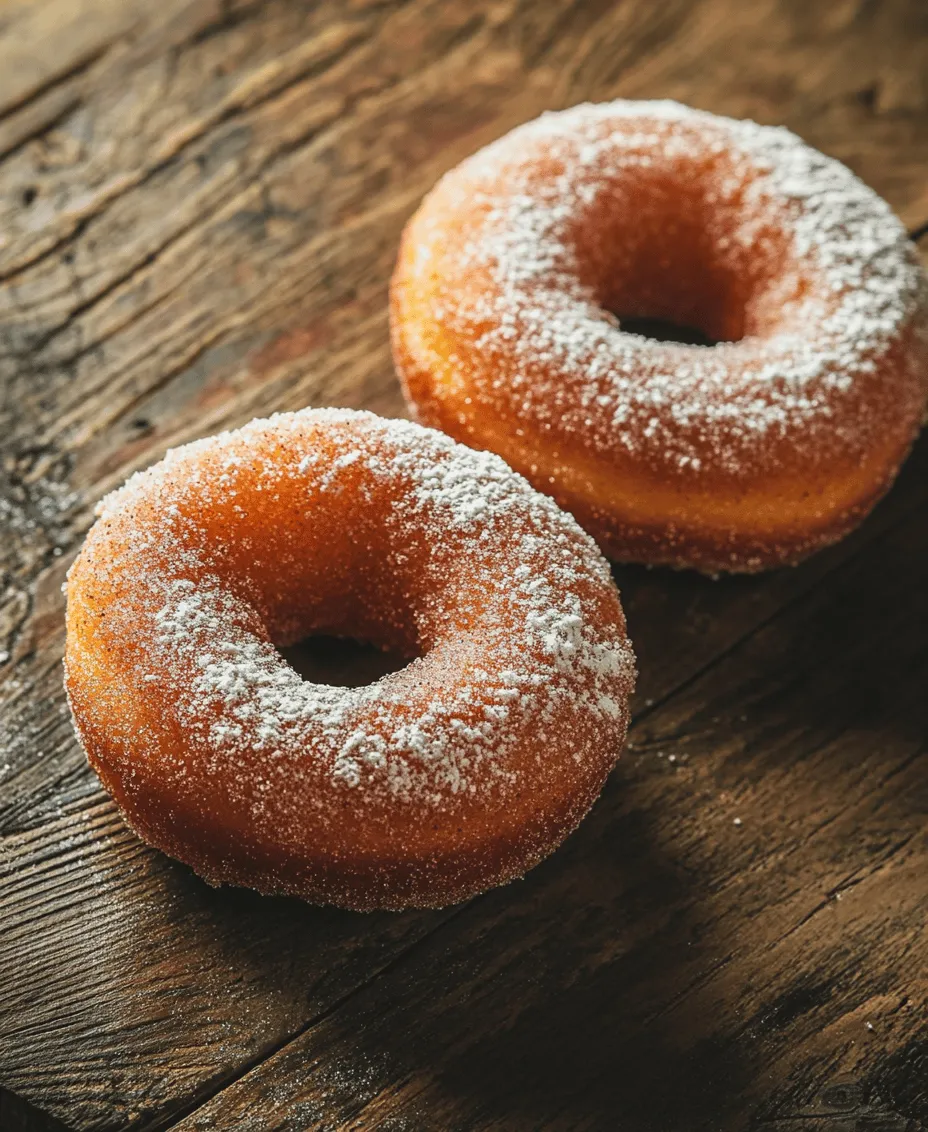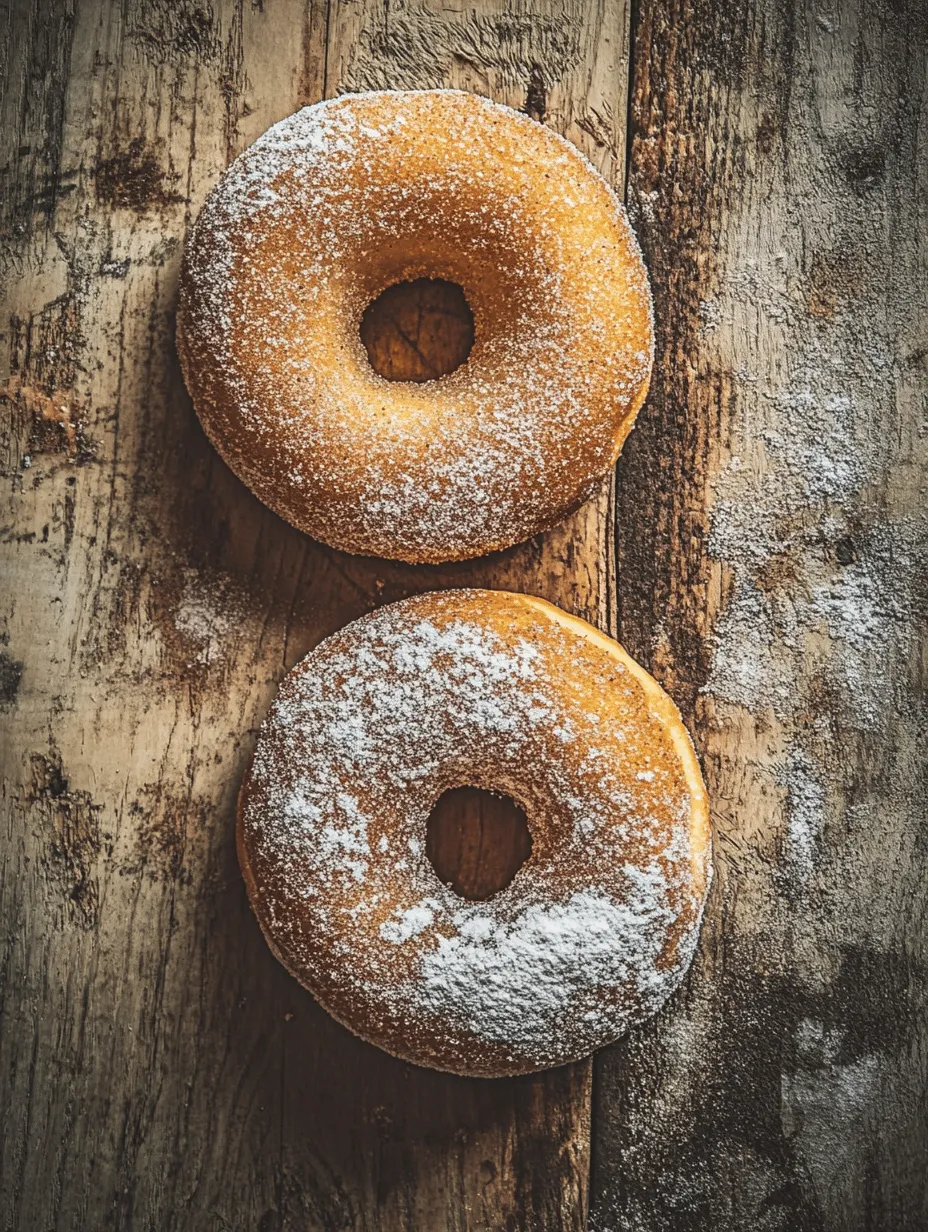Introduction
As the leaves turn golden and the air turns crisp, fall unveils a delightful array of seasonal treats, and among them, apple cider donuts reign supreme. These warm, spiced delights are a staple at autumn festivals, farmers’ markets, and cozy bakeries across the country. The combination of apple cider’s natural sweetness and the comforting warmth of cinnamon and nutmeg makes these donuts a favorite for many. Not only do they capture the essence of the season, but they also evoke nostalgia, reminding us of childhood visits to orchards and family gatherings around the harvest table.
The beauty of apple cider donuts lies not only in their flavor but also in their accessibility. They are surprisingly easy to make at home, catering to bakers of all skill levels. Whether you’re a seasoned pro or just starting your baking journey, this recipe will guide you through the simple steps to create a batch of irresistible apple cider donuts that are sure to impress family and friends.
Understanding Apple Cider Donuts
So, what exactly makes apple cider donuts distinct compared to traditional donuts? Unlike their yeast-leavened counterparts, which often have a light and airy texture, apple cider donuts are typically cake-based. This difference in preparation results in a denser, more substantial donut that holds up beautifully to the flavors of apple cider and spices. The cake-like texture allows for a satisfying bite, making each mouthful a delightful experience.
The history of apple cider donuts dates back to the early 20th century, particularly in the New England region, where apple picking and cider making are longstanding traditions. As communities began celebrating the harvest season, apple cider donuts became a beloved treat, often enjoyed fresh from the fryer at autumn fairs and festivals. Their cultural significance continues today, symbolizing the warmth of home and the joy of gathering during the cooler months.
The flavor and texture imparted by apple cider are what truly elevate these donuts. The cider not only adds sweetness but also infuses each bite with a rich apple flavor that complements the warm spices typically associated with fall baking. The result is a donut that is both comforting and refreshing, making it the perfect indulgence for those crisp, autumn days.
Ingredients Breakdown
To create the perfect batch of apple cider donuts, you’ll want to select your ingredients thoughtfully. Each component plays a crucial role in achieving the desired flavor, texture, and overall quality of the final product.
Apple Cider
The star ingredient in apple cider donuts is, of course, apple cider. Selecting a high-quality cider is essential for maximizing flavor and moisture. Fresh, unfiltered apple cider, preferably from a local orchard, will provide the richest apple flavor. Avoid using clear apple juice as it lacks the depth that cider brings. The cider not only sweetens the donuts but also adds moisture, making them tender and delicious.
Flours
A combination of all-purpose flour and whole wheat flour is often used in apple cider donuts. All-purpose flour gives the donuts a light texture, while whole wheat flour adds a nutty flavor and additional nutritional benefits. The blend of these flours creates a balanced dough that holds together well during frying or baking, resulting in a satisfying bite.
Leavening Agents
Baking powder and baking soda are crucial for achieving the right rise in your donuts. Baking powder is a double-acting leavening agent that provides lift during the baking process, while baking soda helps neutralize the acidity of the apple cider. Together, they create the perfect rise and texture, ensuring your donuts are fluffy and light.
Spices
No apple cider donut would be complete without the warm, aromatic spices that define its flavor profile. Ground cinnamon and nutmeg are the most commonly used spices in this recipe. Cinnamon adds warmth and sweetness, while nutmeg contributes a slightly nutty and earthy flavor. Beyond their delicious taste, both spices offer health benefits, including anti-inflammatory properties and digestive support, making your treat a little more wholesome.
Sweeteners
Granulated sugar is typically used to sweeten apple cider donuts, but incorporating applesauce into the mix can enhance the flavor and moisture. The natural sweetness of applesauce works harmoniously with the cider, creating a rich, flavorful donut that isn’t overly sweet. Together, these sweeteners help achieve the perfect balance, allowing the apple flavor to shine through.
Eggs and Butter
The inclusion of eggs and melted butter adds richness and moisture to the donuts. Eggs act as a binder, providing structure and stability, while the melted butter enhances the flavor and creates a tender crumb. This combination results in a donut that is not only delicious but also has a satisfying mouthfeel.
Optional Coatings
While apple cider donuts are delightful on their own, many bakers choose to finish them with a coating for an extra touch of sweetness. A simple dusting of powdered sugar can enhance the visual appeal and add a light sweetness, while a cinnamon-sugar coating adds a delightful crunch and extra warmth. Either option elevates the donut experience, making them even more irresistible.
Step-by-Step Guide to Making Apple Cider Donuts
Now that you have a solid understanding of the ingredients and their importance, let’s delve into the steps for making your own apple cider donuts.
Step 1: Reduce the Apple Cider
To intensify the apple flavor, begin by reducing the apple cider. Pour 2 cups of fresh apple cider into a saucepan and bring it to a boil over medium-high heat. Allow it to simmer until the volume is reduced to about 1 cup. This process concentrates the flavor and sweetness, making your donuts even more delicious. Once reduced, let the cider cool before incorporating it into your batter.
Step 2: Prepare the Dry Ingredients
In a mixing bowl, whisk together the dry ingredients. Combine 1 ½ cups of all-purpose flour, ½ cup of whole wheat flour, 2 teaspoons of baking powder, ½ teaspoon of baking soda, and 1 teaspoon of ground cinnamon. Add in ¼ teaspoon of ground nutmeg and a pinch of salt. Whisking the dry ingredients helps to evenly distribute the leavening agents and spices, ensuring consistent flavor throughout the donuts.
Step 3: Combine the Wet Ingredients
In another bowl, combine the wet ingredients. Beat together 1 large egg, ¾ cup of granulated sugar, and ¼ cup of melted butter until smooth. Gradually mix in the reduced apple cider and ½ cup of unsweetened applesauce. The combination of wet ingredients creates a rich and flavorful base for your donuts.
Step 4: Mix the Batter
Gently fold the dry ingredients into the wet mixture using a spatula. Be careful not to overmix; a few lumps are perfectly fine. Overmixing can lead to dense donuts, so mix just until the dry ingredients are incorporated. The batter should be thick and slightly lumpy, but well combined.
Step 5: Prepare for Frying or Baking
If you’re frying the donuts, heat vegetable oil in a deep pot or fryer to 375°F (190°C). For baking, preheat your oven to 350°F (175°C) and grease a donut pan generously. If you don’t have a donut pan, you can also use a muffin tin, though the shape will differ slightly.
Step 6: Fill the Mold
Using a piping bag or a spoon, fill each cavity of the donut pan (or muffin tin) about two-thirds full with the batter. If frying, you can use a spoon to carefully drop spoonfuls of batter into the hot oil, shaping them into rings if desired.
This marks the beginning of your delicious journey into creating homemade apple cider donuts. The next steps will guide you through the frying or baking process, ensuring that your donuts turn out perfectly golden and flavorful. Stay tuned for more detailed instructions on how to finish these delightful treats!

Preparation
Before diving into the delightful world of baking apple cider donuts, it’s vital to prepare your kitchen for success. Preheating the oven to 350°F (175°C) is essential as it ensures that the donuts cook evenly and thoroughly. An adequately preheated oven promotes the perfect rise and texture, contributing to that light and fluffy bite you crave.
Equally important is greasing your donut pan. Use a non-stick spray or a light coating of melted butter to ensure that your donuts release effortlessly from the pan. This step is crucial; no one wants to face the disappointment of a delicious donut that sticks and crumbles rather than coming out in one beautiful piece.
Reducing Apple Cider
The heart of these irresistible apple cider donuts lies in the apple cider reduction. Reducing apple cider concentrates its flavors and sweetness, making it a star ingredient in your batter. To start, pour about 2 cups of apple cider into a saucepan and bring it to a gentle boil over medium heat. Once boiling, reduce the heat to low and let it simmer. It’s essential to stir occasionally to prevent burning.
Continue simmering until the cider has reduced to about ½ cup, which should take roughly 15-20 minutes. You’re looking for a thick syrup-like consistency that’s rich in flavor. This reduction not only enhances the taste of your donuts but also adds moisture, ensuring they stay soft and inviting. Once reduced, allow the cider to cool before incorporating it into your batter.
Mixing Dry Ingredients
To create a perfectly balanced donut, it’s essential to mix your dry ingredients thoroughly. Start by sifting together 1 ½ cups of all-purpose flour, ½ cup of granulated sugar, 1 tablespoon of baking powder, ½ teaspoon of baking soda, ½ teaspoon of salt, and 1 teaspoon of ground cinnamon in a large mixing bowl. Sifting helps eliminate any lumps and ensures that your leavening agents are evenly distributed throughout the flour.
Incorporating the right amount of air into this mixture is vital, as it contributes to the rise of your donuts. After sifting, whisk the dry ingredients together for a minute or two. This step not only combines them but also helps aerate the mixture, which is key for achieving that light and fluffy texture in your final product.
Combining Wet Ingredients
Next, it’s time to focus on the wet ingredients. In a separate bowl, whisk together 2 large eggs, ½ cup of granulated sugar, ½ cup of brown sugar, ½ cup of whole milk, ½ cup of the cooled apple cider reduction, and ½ teaspoon of vanilla extract. Mixing these ingredients well is crucial to achieving a smooth batter. Make sure to blend the eggs and sugars together until the mixture is light and frothy; this introduces air, which is essential for a soft and airy donut.
After the wet ingredients are combined, slowly incorporate the dry ingredients. It’s best to do this in two or three additions, gently folding the mixture with a spatula until just combined. The goal is to achieve a uniform batter without overmixing, which can lead to dense donuts.
Folding Techniques
When it comes to folding in your ingredients, gentle is the key. Overworking the batter can activate the gluten in the flour, resulting in tough donuts. To fold properly, use a spatula to scoop from the bottom of the bowl and turn the batter over on itself. Rotate the bowl as you work; this method ensures even mixing without excessive agitation. Stop folding as soon as you no longer see dry flour; a few small lumps are perfectly acceptable.
Filling the Donut Pan
Now that your batter is ready, it’s time to fill the donut pan. A great way to achieve uniform shapes is to use a piping bag or a zip-top bag with a corner snipped off. This method allows for better control and less mess. Fill each cavity about ¾ full to allow room for the donuts to rise without overflowing.
If you don’t have a piping bag, you can use a spoon, but be careful to distribute the batter evenly. Remember, the more uniform the batter distribution, the more consistent your donuts will bake.
Baking Process
Once filled, place the donut pan in your preheated oven and bake for about 10-12 minutes. Keep an eye on them; the donuts are done when they spring back lightly when touched and have a golden-brown color. You can also check for doneness by inserting a toothpick into the center of a donut; it should come out clean.
After baking, allow the donuts to cool in the pan for about 5 minutes before transferring them to a wire rack. This cooling period is crucial as it allows them to set properly and enhances their texture. Let them cool completely before proceeding to the coating step.
Coating Techniques
Now comes the fun part: coating your apple cider donuts! There are several creative ways to add flavor and aesthetics to your treats. The classic method is to roll your warm donuts in a mixture of granulated sugar and cinnamon. This not only adds sweetness but also gives an appealing finish.
For a different twist, consider glazing your donuts. A simple glaze can be made by whisking together powdered sugar and a splash of milk or apple cider until smooth. Dip the tops of the cooled donuts into the glaze, allowing any excess to drip off before placing them back on the wire rack to let the glaze set.
You could also get adventurous with toppings such as chopped nuts, sprinkles, or coconut flakes for added texture. Whether you choose to coat, glaze, or leave them plain, your apple cider donuts will be beautiful and inviting.
Serving Suggestions
These apple cider donuts are best enjoyed fresh but can be served in various delightful ways. For a cozy breakfast or snack, serve them warm alongside a cup of coffee or your favorite hot beverage. Pairing them with a steaming mug of hot apple cider enhances their flavor profile, making for a comforting seasonal treat.
If you’re hosting a gathering, consider serving the donuts on a decorative platter, dusted with powdered sugar for that extra touch. You can also create a delightful dessert table with an assortment of pastries, including these apple cider donuts, for your guests to enjoy.
For a brunch event, serving them with spiced tea or even a pumpkin-flavored latte will surely impress your guests. Presentation can elevate the experience; consider using fall-themed decorations like small pumpkins or autumn leaves around your serving dish.
Nutritional Information
Understanding the nutritional aspects of your homemade apple cider donuts is essential, especially if you’re mindful of your dietary choices. Each donut contains a mix of ingredients that can offer some benefits. The apples in the cider provide vitamins and antioxidants, while whole milk adds calcium and protein.
However, it’s important to be aware of portion sizes. While these treats are delicious, enjoying them in moderation is key to maintaining a balanced diet. One or two donuts can fit into a well-rounded meal, especially when paired with healthier options like fresh fruit or yogurt.
Conclusion
The charm of homemade apple cider donuts lies in their warm, comforting flavor and the joy they bring to any occasion. From the satisfying process of reduction to the delightful moment of coating, baking these donuts is an experience that embodies the essence of fall.
Embrace the joy of seasonal baking and create lasting memories by sharing these treats with family and friends. There’s something special about offering homemade goodies that foster a sense of connection and warmth. So roll up your sleeves, gather your ingredients, and indulge in the satisfaction of creating delicious recipes right in your kitchen. Your apple cider donuts are sure to become a cherished favorite, inviting everyone to gather around and savor the flavors of the season.



